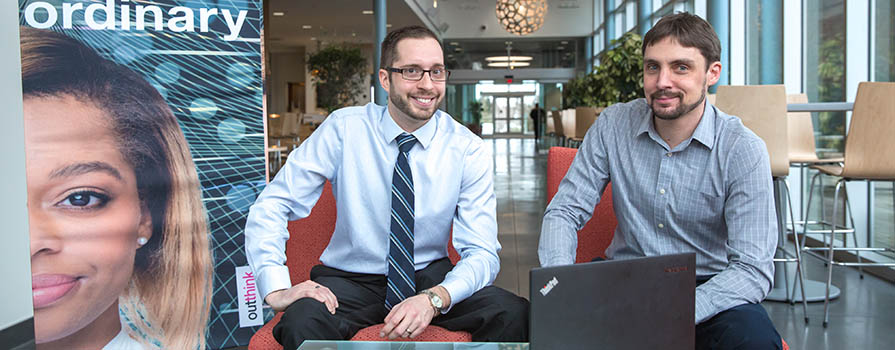Mastering the mainframe

When contestants representing more than 400 schools from across North America went head to head in the 2016 IBM Master the Mainframe Contest, two first year NSCC Information Technology Programming students emerged in the top one percent of the more than 4,000 participants.
Michael Robinson (Institute of Technology) and Elliott Siewert (Truro Campus) each received an honorable mention and two digital awards for their ability to perform extensive programming, while innovating on the mainframe to solve real life situations encountered by experienced developers.
“From what I heard before the contest, I knew it would be challenging and near impossible to complete,” says Michael. “I liked the idea of accepting the challenge, learning something new and seeing how far I could go.”
IBM and our clients are constantly in search of promising new talent who can work with the core systems vital to the global economy. These students demonstrate the creativity and initiative that are needed to develop the next generation of innovation on the mainframe.
Understanding the mainframe
With just a username and a password or a fingerprint, the average computer user can log in and out of their online banking, personal email, and work. “What the average user does not realize is that they are not logging onto a website, they’re logging onto the mainframe,” says Elliott.
The mainframe is a computer that can support thousands of applications and input/output devices—such as laptops and smartphones—and simultaneously serve thousands of users. Today, mainframe computers play a central role in the daily operations of the world's largest corporations. IT professionals who can adeptly navigate the mainframe and enhance its security and efficiency are in high-demand.
“There’s a skills shortage for programming and working with mainframe computers,” says Elliott. “When I came to NSCC, I knew I wanted to learn as much about the industry as I could. This seemed like a great opportunity to supplement my class material, improve my skill set, and help me stand out when applying for jobs.”
Small badge, big deal
With their achievement, IBM has granted Siewert and Robinson the ability to digitally-display two of its coveted “Open Badges” as part of their professional profiles. For completing the two advanced sections of the competition, both Robinson and Siewert received the IBM Practical Experience Open Badge, and the IBM Real World Challenge Open Badge.
The badges are recognized, respected and valued globally in the IT industry as verification of expertise in navigating multiple operating systems. The badges link to IBM-hosted information on Siewert and Robinson’s qualifications and the rigorous process endured to earn them.
Employers can also use the badges to evaluate an individual’s potential.
“A badge demonstrates that we can learn new and unfamiliar technology quickly and independently,” says Michael. “In the tech industry, change happens quickly and constantly. To have these skills validated by a large, reputable company like IBM will be a major benefit as we move forward in our careers.”
UPDATE: We have received word that a third NSCC student has placed in the top 1% and received the IBM Practical Experience Open Badge, and the IBM Real World Challenge Open Badge. Congratulations to Carson Kuzniar, a second year Information Technology (Database Administration) student at our IT Campus.
Fast Fact
The three-part Master the Mainframe contest promotes computer science education and mainframe skills around the world. High school and post-secondary students from over 38 countries on six continents compete, gaining real-world enterprise computing experience.

